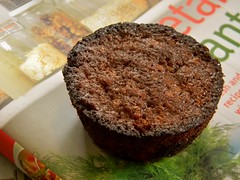 The Healing Herbs Cookbook
The Healing Herbs CookbookAuthor: Pat Crocker
Publisher: Robert Rose (2013)
Herbs have long been reputed as nature’s pharmacy. For millennia, civilizations have relied on plants harvested from local areas to treat illness and infections as well as promoting general wellness. Figuring out what to do with herbs in modern day cooking, though is a relatively lost art limited mostly to flavour enhancement via grocery store staples. Pat Crocker, author of The Vegan Cook’s Bible, takes on the challenge of bringing more exotic herbs home with her latest piece – The Healing Herbs Cookbook.
Healing Herbs is not simply a cookbook, nor does it rely on the use of only
common herbs. Crocker begins the book with what could be considered a miniature
herbology textbook – with a discussion of herb history, an encyclopedia of
different plants used in modern culinary and medicinal practice, advice about
cooking with herbs and even a few pieces of advice about preparing her specific
recipes. At the back of the book, Crocker also includes a handy glossary,
resource guide and bibliography for further reading should you choose to
further your herb studies.
One of the unique traits of Healing
Herbs is that the recipes are not simply organized by type of dish (i.e.
mains, soup) but also by season. This provides a handy idea of what we as
consumers should be on the lookout for at the farmer’s market, and, if you want
to grow your own, greenhouses. The seasonality of the herbs also piques
interest as to what to search for in the local wilderness (although you should always check the local laws, as well as
with the owners of the property (if private) and be sure of the safety of the
plants before foraging and especially
eating any wild plants). For instance, this blustery winter day could easily
call for a bowl of Roasted Squash,
Caramelized onion and Garlic Soup (p. 78), made with woodsy, robust
rosemary and thyme, or a serving of thyme, shiitake and sage-laced Winter Vegetable Lasagna (p. 116). When the
summer heat beckons us all outside though, Immune-Spiced
Soba Noodle Salad (p. 143) sounds like a perfect lunch – especially with
some Poached Cherries with Rosemary
Custard (p. 153) for dessert.
I will say that most of the recipes in Healing
Herbs are not for the amateur cook or palate – if traditional hot and sour
soup from the local Chinese-American restaurant is your usual Asian fare, the
ginseng and burdock in Crocker’s version (p.
70) may be a bit too “out there” for you to stomach. Likewise, Crocker often
calls for many hard to find, odd looking and strange-tasting ingredients which
can easily put off readers who don’t have access to varied international
markets or have more timid palates. Some items taste downright medicinal
(chamomile, hyssop and echinacea come to mind), and simply won’t jive with
those who lack the taste for stereotypical “health food”.
That said, there are some recipes in this volume that are easy and accessible to
almost everyone, not to mention they’re attuned to the “common” Western
tastebuds. The Eggplant Manicotti with
Spinach Manicotti Stuffing (p. 105), for example, is everything an Italian
carb-watcher could want, being filled with basil, spinach and garlic-laced
cheese and topped with simple tomato sauce. To her credit, Crocker also
includes more common options for many exotic ingredients in her recipes. If ramps
and maitake mushrooms aren’t your grocery store’s usual stock, regular old leeks
and cremini or shiitake mushrooms will make a fine Cream of Mushroom Soup (p. 66). A few recipes are still beyond
reach for the average cook, but most of the limitations are totally up to the
palate of the reader.
With the abundance of medications being
prescribed today, more of us would do better turning to the garden for
prevention and cooperative treatment. While modern medicine lack taste and can
in fact become useless when bacteria mutate and become resistant to the
chemicals, herbs are biodynamic and flavourful options for meals, sides and
desserts. With The Healing Herbs Cookbook, Pat Crocker endeavours to
bring the nutritious and the delicious together, opening up a new world of
healthy possibilities.
 |
| Asparagus Three-Cheese Burritos with Tomato Sauce (p. 96) |
Available on Amazon



